2016 NISSAN ALTIMA SEDAN fog light
[x] Cancel search: fog lightPage 197 of 491
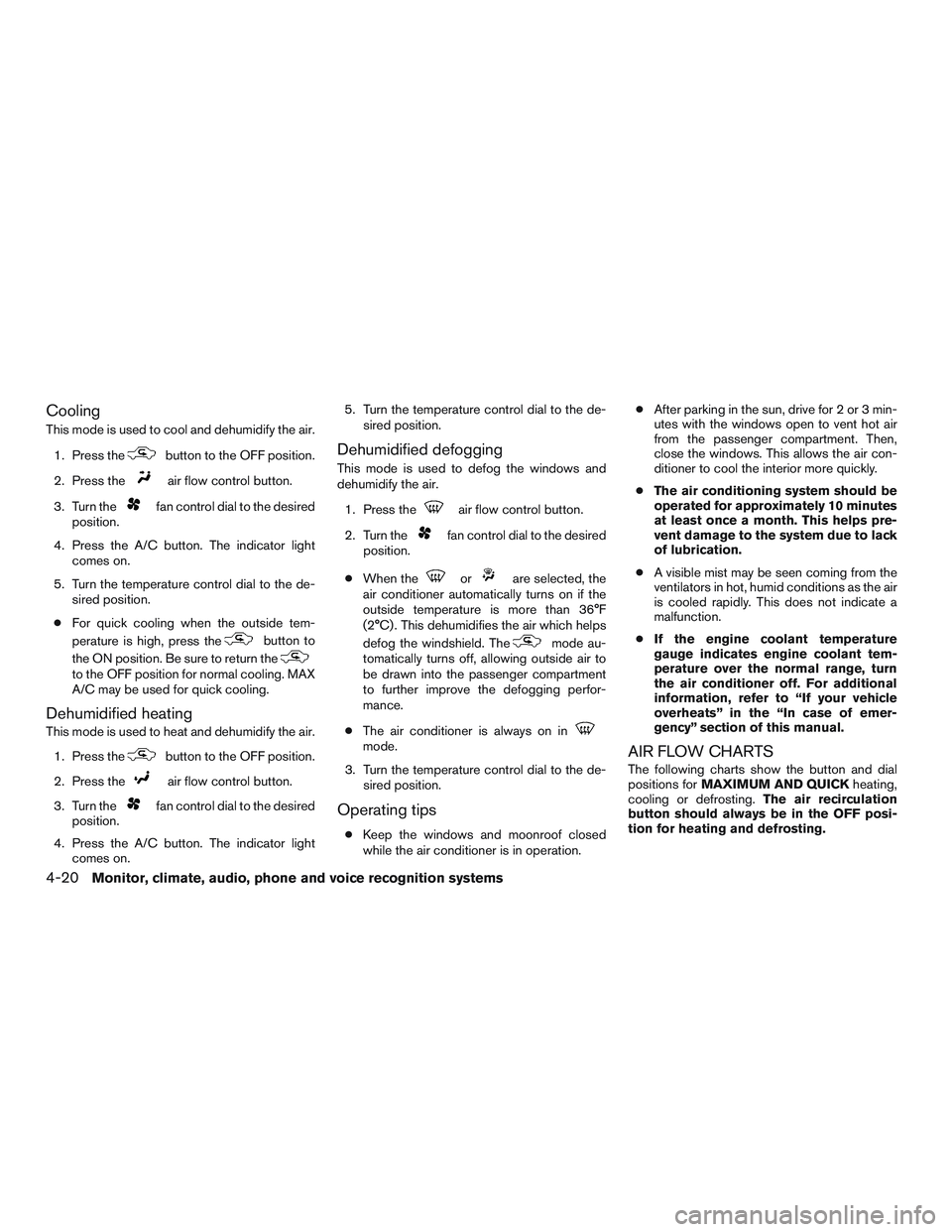
Cooling
This mode is used to cool and dehumidify the air.1. Press the
button to the OFF position.
2. Press the
air flow control button.
3. Turn the
fan control dial to the desired
position.
4. Press the A/C button. The indicator light comes on.
5. Turn the temperature control dial to the de- sired position.
● For quick cooling when the outside tem-
perature is high, press the
button to
the ON position. Be sure to return the
to the OFF position for normal cooling. MAX
A/C may be used for quick cooling.
Dehumidified heating
This mode is used to heat and dehumidify the air.
1. Press the
button to the OFF position.
2. Press the
air flow control button.
3. Turn the
fan control dial to the desired
position.
4. Press the A/C button. The indicator light comes on. 5. Turn the temperature control dial to the de-
sired position.
Dehumidified defogging
This mode is used to defog the windows and
dehumidify the air.
1. Press the
air flow control button.
2. Turn the
fan control dial to the desired
position.
● When the
orare selected, the
air conditioner automatically turns on if the
outside temperature is more than 36°F
(2°C) . This dehumidifies the air which helps
defog the windshield. The
mode au-
tomatically turns off, allowing outside air to
be drawn into the passenger compartment
to further improve the defogging perfor-
mance.
● The air conditioner is always on in
mode.
3. Turn the temperature control dial to the de- sired position.
Operating tips
●Keep the windows and moonroof closed
while the air conditioner is in operation. ●
After parking in the sun, drive for 2 or 3 min-
utes with the windows open to vent hot air
from the passenger compartment. Then,
close the windows. This allows the air con-
ditioner to cool the interior more quickly.
● The air conditioning system should be
operated for approximately 10 minutes
at least once a month. This helps pre-
vent damage to the system due to lack
of lubrication.
● A visible mist may be seen coming from the
ventilators in hot, humid conditions as the air
is cooled rapidly. This does not indicate a
malfunction.
● If the engine coolant temperature
gauge indicates engine coolant tem-
perature over the normal range, turn
the air conditioner off. For additional
information, refer to “If your vehicle
overheats” in the “In case of emer-
gency” section of this manual.
AIR FLOW CHARTS
The following charts show the button and dial
positions for MAXIMUM AND QUICK heating,
cooling or defrosting. The air recirculation
button should always be in the OFF posi-
tion for heating and defrosting.
4-20Monitor, climate, audio, phone and voice recognition systems
Page 338 of 491
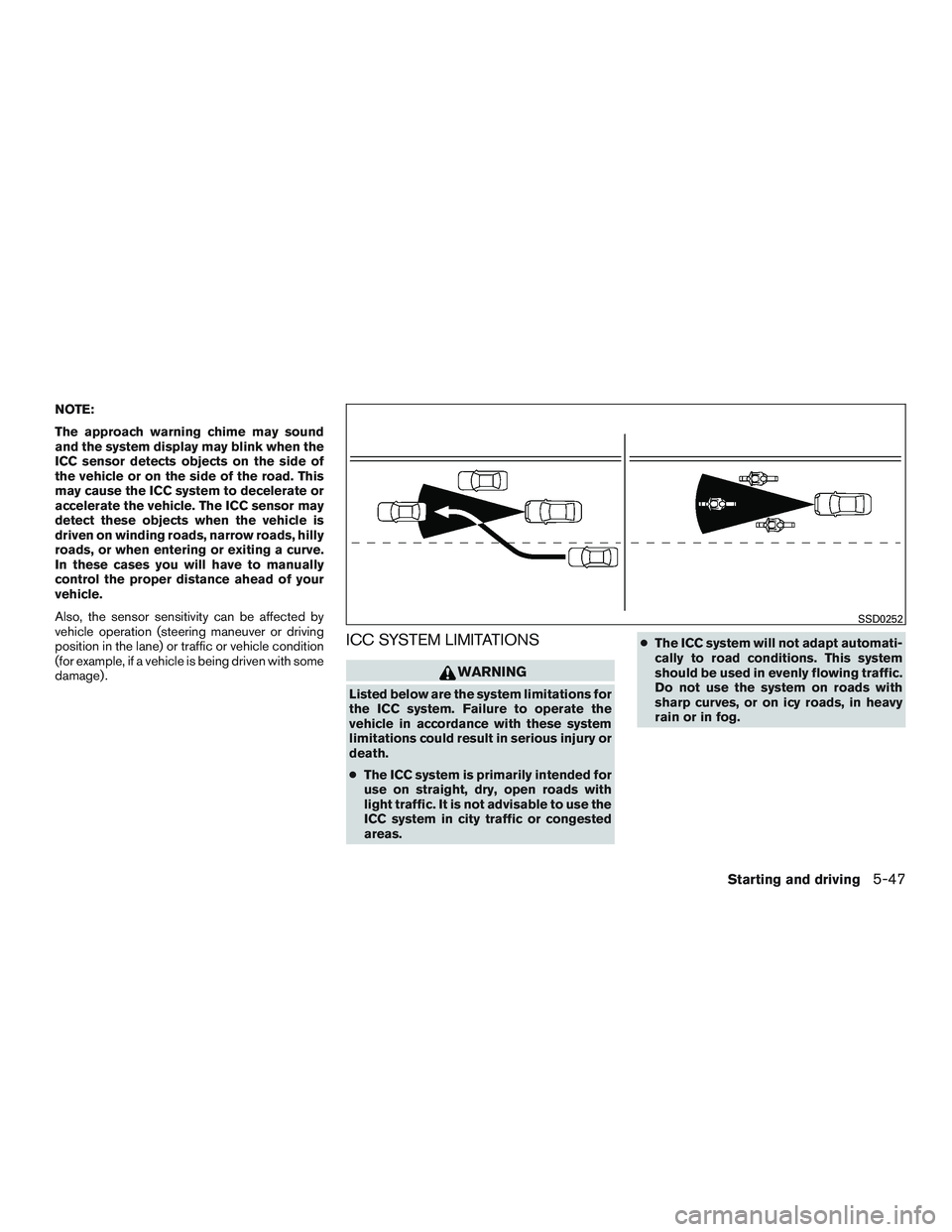
NOTE:
The approach warning chime may sound
and the system display may blink when the
ICC sensor detects objects on the side of
the vehicle or on the side of the road. This
may cause the ICC system to decelerate or
accelerate the vehicle. The ICC sensor may
detect these objects when the vehicle is
driven on winding roads, narrow roads, hilly
roads, or when entering or exiting a curve.
In these cases you will have to manually
control the proper distance ahead of your
vehicle.
Also, the sensor sensitivity can be affected by
vehicle operation (steering maneuver or driving
position in the lane) or traffic or vehicle condition
(for example, if a vehicle is being driven with some
damage) .
ICC SYSTEM LIMITATIONS
WARNING
Listed below are the system limitations for
the ICC system. Failure to operate the
vehicle in accordance with these system
limitations could result in serious injury or
death.
●The ICC system is primarily intended for
use on straight, dry, open roads with
light traffic. It is not advisable to use the
ICC system in city traffic or congested
areas. ●
The ICC system will not adapt automati-
cally to road conditions. This system
should be used in evenly flowing traffic.
Do not use the system on roads with
sharp curves, or on icy roads, in heavy
rain or in fog.
SSD0252
Starting and driving5-47
Page 400 of 491
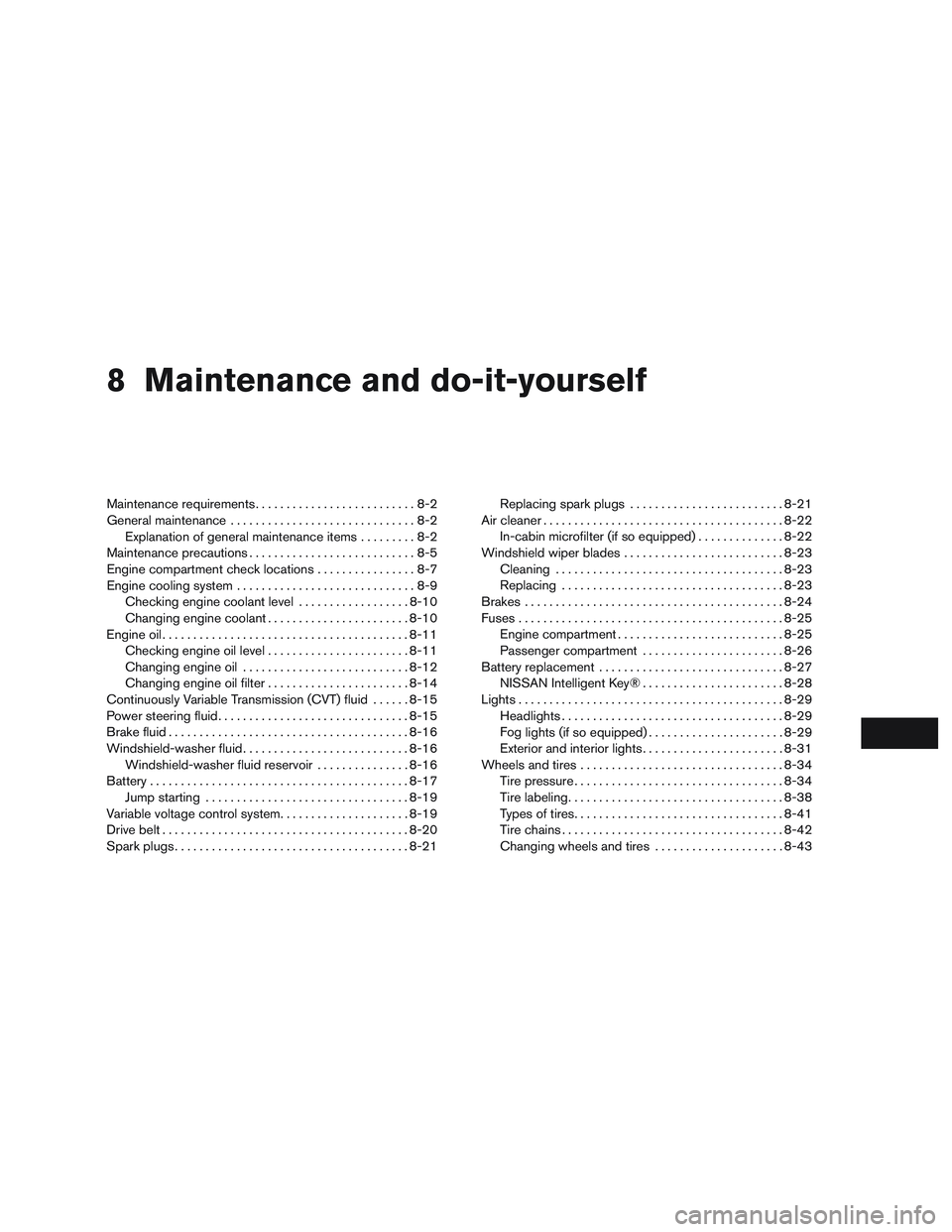
8 Maintenance and do-it-yourself
Maintenance requirements..........................8-2
General maintenance ..............................8-2
Explanation of general maintenance items .........8-2
Maintenance precautions ...........................8-5
Engine compartment check locations ................8-7
Engine cooling system .............................8-9
Checking engine coolant level ..................8-10
Changing engine coolant .......................8-10
Engine oil ........................................ 8-11
Checking engine oil level .......................8-11
Changing engine oil ........................... 8-12
Changing engine oil filter .......................8-14
Continuously Variable Transmission (CVT) fluid ......8-15
Power steering fluid ............................... 8-15
Brake fluid ....................................... 8-16
Windshield-washer fluid ........................... 8-16
Windshield-washer fluid reservoir ...............8-16
Battery .......................................... 8-17
Jump starting ................................. 8-19
Variable voltage control system .....................8-19
Drive belt ........................................ 8-20
Spark plugs ...................................... 8-21Replacing spark plugs
......................... 8-21
Air cleaner ....................................... 8-22
In-cabin microfilter (if so equipped) ..............8-22
Windshield wiper blades .......................... 8-23
Cleaning ..................................... 8-23
Replacing .................................... 8-23
Brakes .......................................... 8-24
Fuses ........................................... 8-25
Engine compartment ........................... 8-25
Passenger compartment .......................8-26
Battery replacement .............................. 8-27
NISSAN Intelligent Key® .......................8-28
Lights ........................................... 8-29
Headlights .................................... 8-29
Fog
lights (if so equipped) ...................... 8-29
Exterior and interior lights .......................8-31
Wheels and tires ................................. 8-34
Tire pressure .................................. 8-34
Tire labeling ................................... 8-38
Types of tires .................................. 8-41
Tire chains .................................... 8-42
Changing wheels and tires .....................8-43
Page 428 of 491
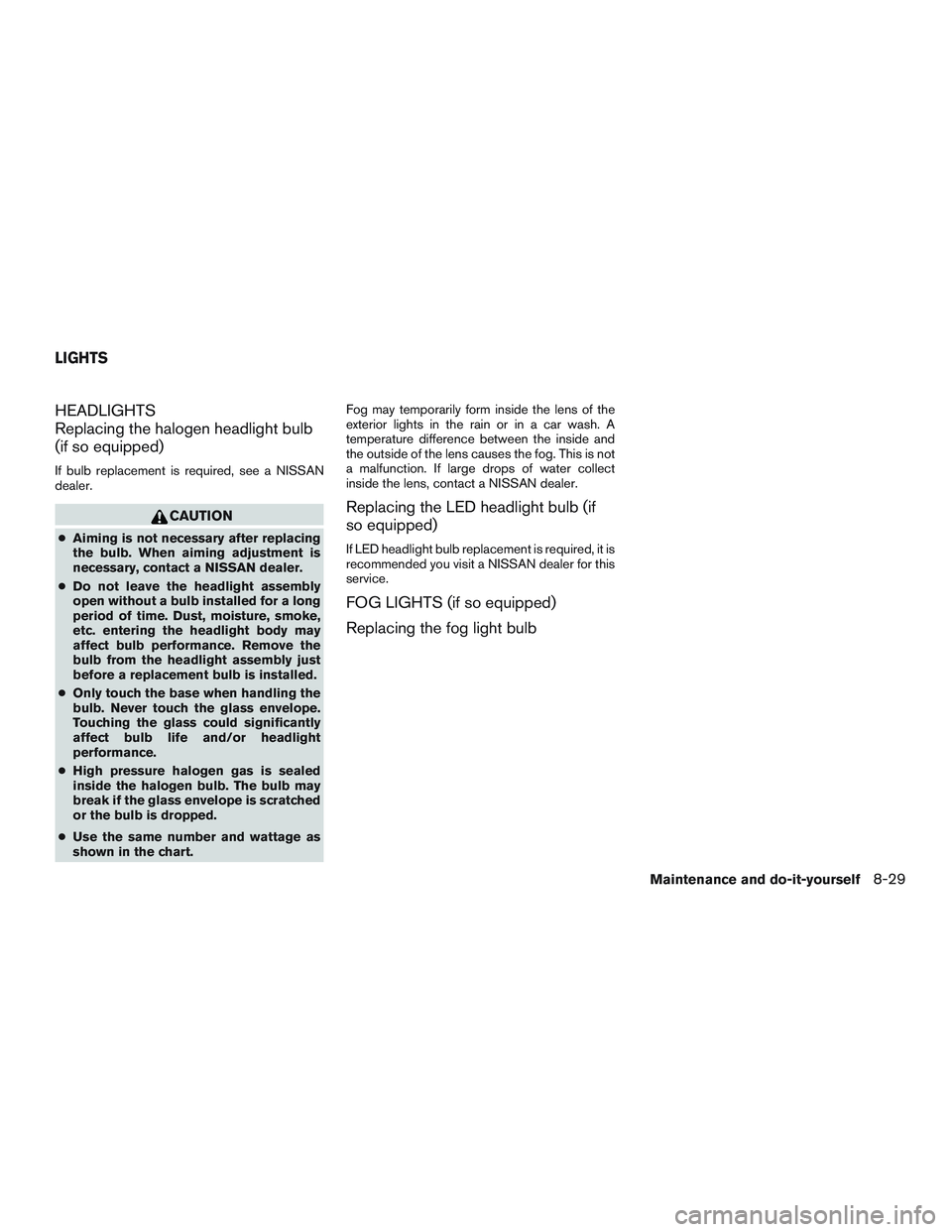
HEADLIGHTS
Replacing the halogen headlight bulb
(if so equipped)
If bulb replacement is required, see a NISSAN
dealer.
CAUTION
●Aiming is not necessary after replacing
the bulb. When aiming adjustment is
necessary, contact a NISSAN dealer.
● Do not leave the headlight assembly
open without a bulb installed for a long
period of time. Dust, moisture, smoke,
etc. entering the headlight body may
affect bulb performance. Remove the
bulb from the headlight assembly just
before a replacement bulb is installed.
● Only touch the base when handling the
bulb. Never touch the glass envelope.
Touching the glass could significantly
affect bulb life and/or headlight
performance.
● High pressure halogen gas is sealed
inside the halogen bulb. The bulb may
break if the glass envelope is scratched
or the bulb is dropped.
● Use the same number and wattage as
shown in the chart. Fog may temporarily form inside the lens of the
exterior lights in the rain or in a car wash. A
temperature difference between the inside and
the outside of the lens causes the fog. This is not
a malfunction. If large drops of water collect
inside the lens, contact a NISSAN dealer.
Replacing the LED headlight bulb (if
so equipped)
If LED headlight bulb replacement is required, it is
recommended you visit a NISSAN dealer for this
service.
FOG LIGHTS (if so equipped)
Replacing the fog light bulb
LIGHTS
Maintenance and do-it-yourself8-29
Page 430 of 491
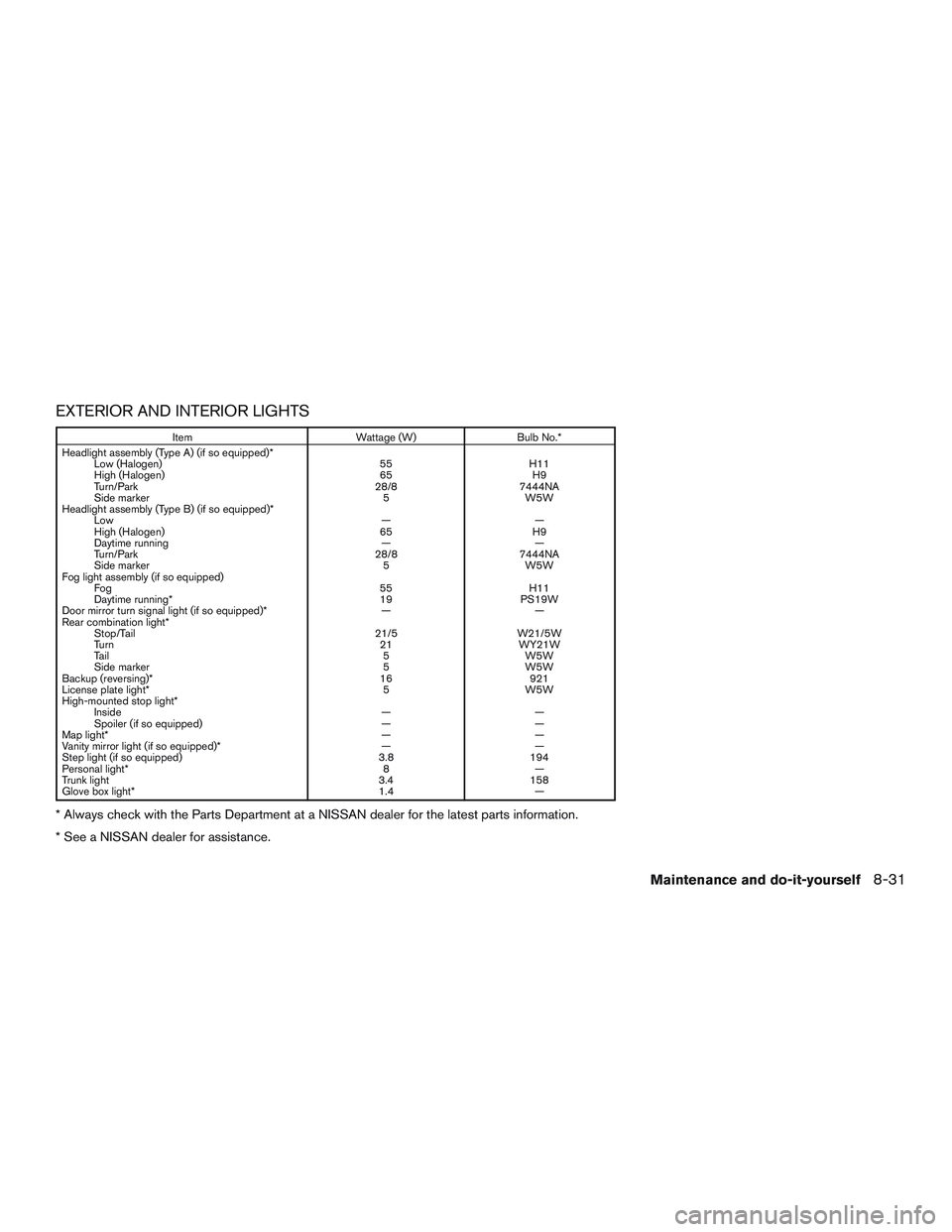
EXTERIOR AND INTERIOR LIGHTS
ItemWattage (W)Bulb No.*
Headlight assembly (Type A) (if so equipped)* Low (Halogen) 55H11
High (Halogen) 65H9
Turn/Park 28/87444NA
Side marker 5W5W
Headlight assembly (Type B) (if so equipped)* Low ——
High (Halogen) 65H9
Daytime running ——
Turn/Park 28/87444NA
Side marker 5W5W
Fog light assembly (if so equipped) Fog 55H11
Daytime running* 19PS19W
Door mirror turn signal light (if so equipped)* ——
Rear combination light* Stop/Tail 21/5W21/5W
Turn 21WY21W
Tail 5W5W
Side marker 5W5W
Backup (reversing)* 16921
License plate light* 5W5W
High-mounted stop light* Inside ——
Spoiler (if so equipped) ——
Map light* ——
Vanity mirror light (if so equipped)* ——
Step light (if so equipped) 3.8194
Personal light* 8—
Trunk light 3.4158
Glove box light* 1.4—
* Always check with the Parts Department at a NISSAN dealer for the latest parts information.
* See a NISSAN dealer for assistance.
Maintenance and do-it-yourself8-31
Page 431 of 491
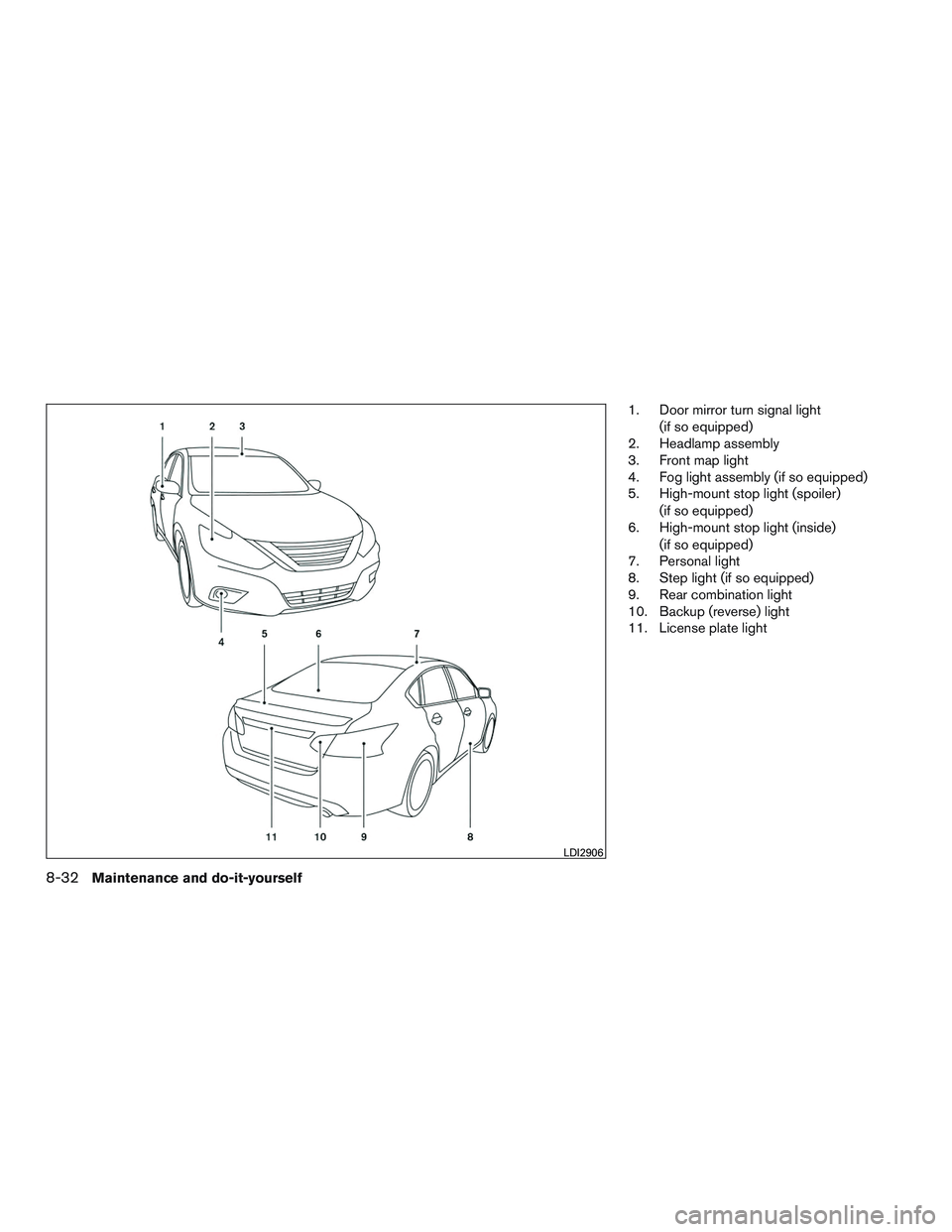
1. Door mirror turn signal light(if so equipped)
2. Headlamp assembly
3. Front map light
4. Fog light assembly (if so equipped)
5. High-mount stop light (spoiler)
(if so equipped)
6. High-mount stop light (inside)
(if so equipped)
7. Personal light
8. Step light (if so equipped)
9. Rear combination light
10. Backup (reverse) light
11. License plate light
LDI2906
8-32Maintenance and do-it-yourself
Page 470 of 491
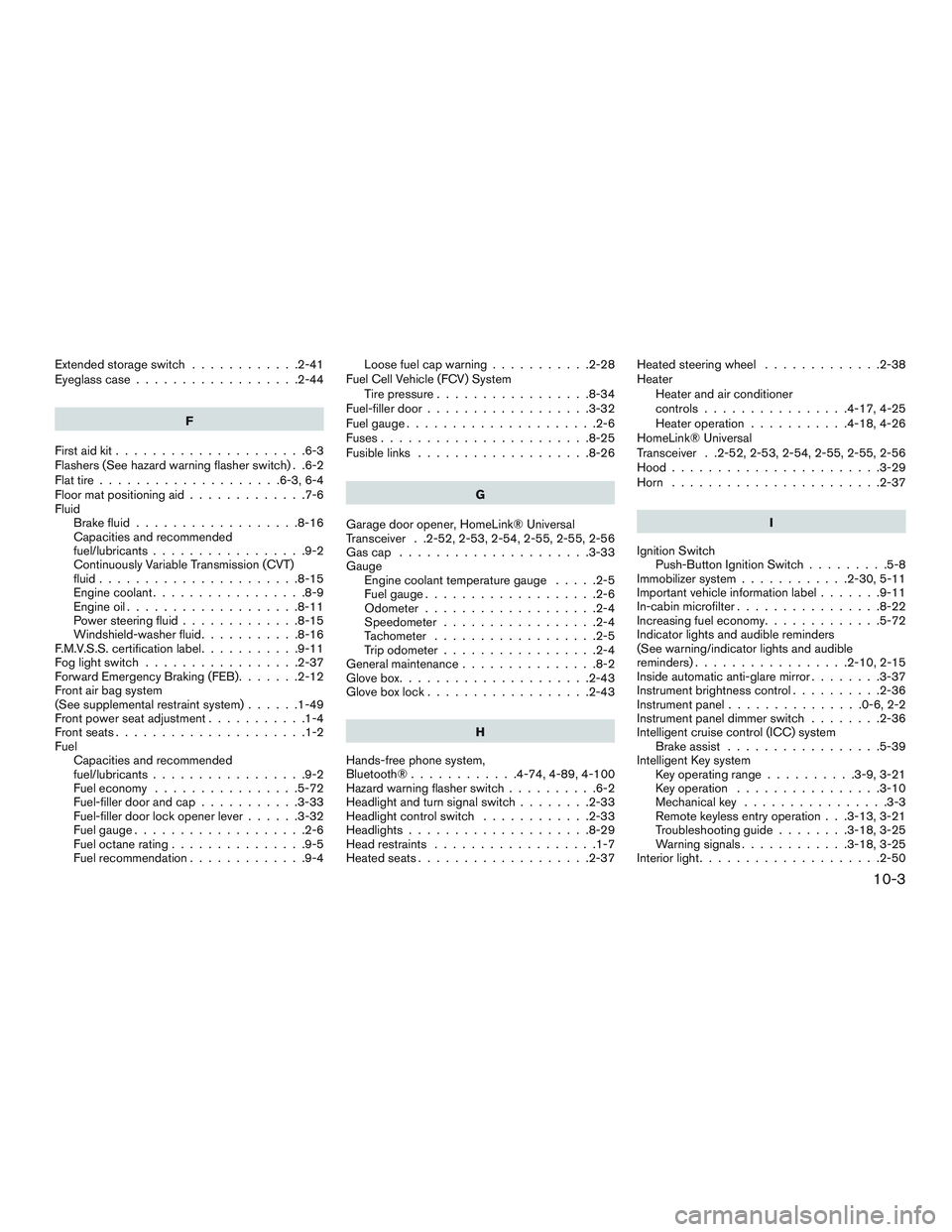
Extendedstorageswitch ............2-41
Eyeglass case..................2-44
F
First aid kit .....................6-3
Flashers (See hazard warning flasher switch) . .6-2
Flat tire ....................6-3,6-4
Floor mat positioning aid .............7-6
Fluid Brake fluid ..................8-16
Capacities and recommended
fuel/lubricants .................9-2
Continuously Variable Transmission (CVT)
fluid......................8-15
Engine coolant .................8-9
Engine oil ...................8-11
Power steering fluid .............8-15
Windshield-washerfluid...........8-16
F.M.V.S.S. certification label ...........9-11
Foglightswitch .................2-37
Forward Emergency Braking (FEB) .......2-12
Front air bag system
(See supplemental restraint system) ......1-49
Front power seat adjustment ...........1-4
Frontseats.....................1-2
Fuel Capacities and recommended
fuel/lubricants .................9-2
Fuel economy ................5-72
Fuel-filler door and cap ...........3-33
Fuel-filler door lock opener lever ......3-32
Fuel gauge ...................2-6
Fuel octane rating ...............9-5
Fuel recommendation .............9-4 Loose fuel cap warning
...........2-28
Fuel Cell Vehicle (FCV) System Tirepressure.................8-34
Fuel-filler door ..................3-32
Fuelgauge.....................2-6
Fuses.......................8-25
Fusiblelinks ...................8-26
G
Garage door opener, HomeLink® Universal
Transceiver . .2-52, 2-53, 2-54, 2-55, 2-55, 2-56
Gascap .....................3-33
Gauge Engine coolant temperature gauge .....2-5
Fuel gauge ...................2-6
Odometer ...................2-4
Speedometer .................2-4
Tachometer ..................2-5
Trip odometer .................2-4
General maintenance ...............8-2
Glovebox.....................2-43
Gloveboxlock..................2-43
H
Hands-free phone system,
Bluetooth®............4-74,4-89,4-100
Hazard warning flasher switch ..........6-2
Headlight and turn signal switch ........2-33
Headlight control switch ............2-33
Headlights ....................8-29
Head restraints ..................1-7
Heated seats ...................2-37 Heated steering wheel
.............2-38
Heater Heater and air conditioner
controls ................4-17,4-25
Heater operation ...........4-18,4-26
HomeLink® Universal
Transceiver . .2-52, 2-53, 2-54, 2-55, 2-55, 2-56
Hood.......................3-29
Horn .......................2-37
I
Ignition Switch Push-Button Ignition Switch .........5-8
Immobilizer system ............2-30,5-11
Important vehicle information label .......9-11
In-cabin microfilter ................8-22
Increasing
fuel economy .............5-72
Indicator lights and audible reminders
(See warning/indicator lights and audible
reminders).................2-10,2-15
Inside automatic anti-glare mirror ........3-37
Instrument brightness control ..........2-36
Instrumentpanel...............0-6,2-2
Instrument panel dimmer switch ........2-36
Intelligent cruise control (ICC) system Brake assist .................5-39
Intelligent Key system Key operating range ..........3-9,3-21
Key operation ................3-10
Mechanical key ................3-3
Remote keyless entry operation . . .3-13, 3-21
Troubleshooting guide ........3-18,3-25
Warning signals ............3-18,3-25
Interior light ....................2-50
10-3
Page 471 of 491
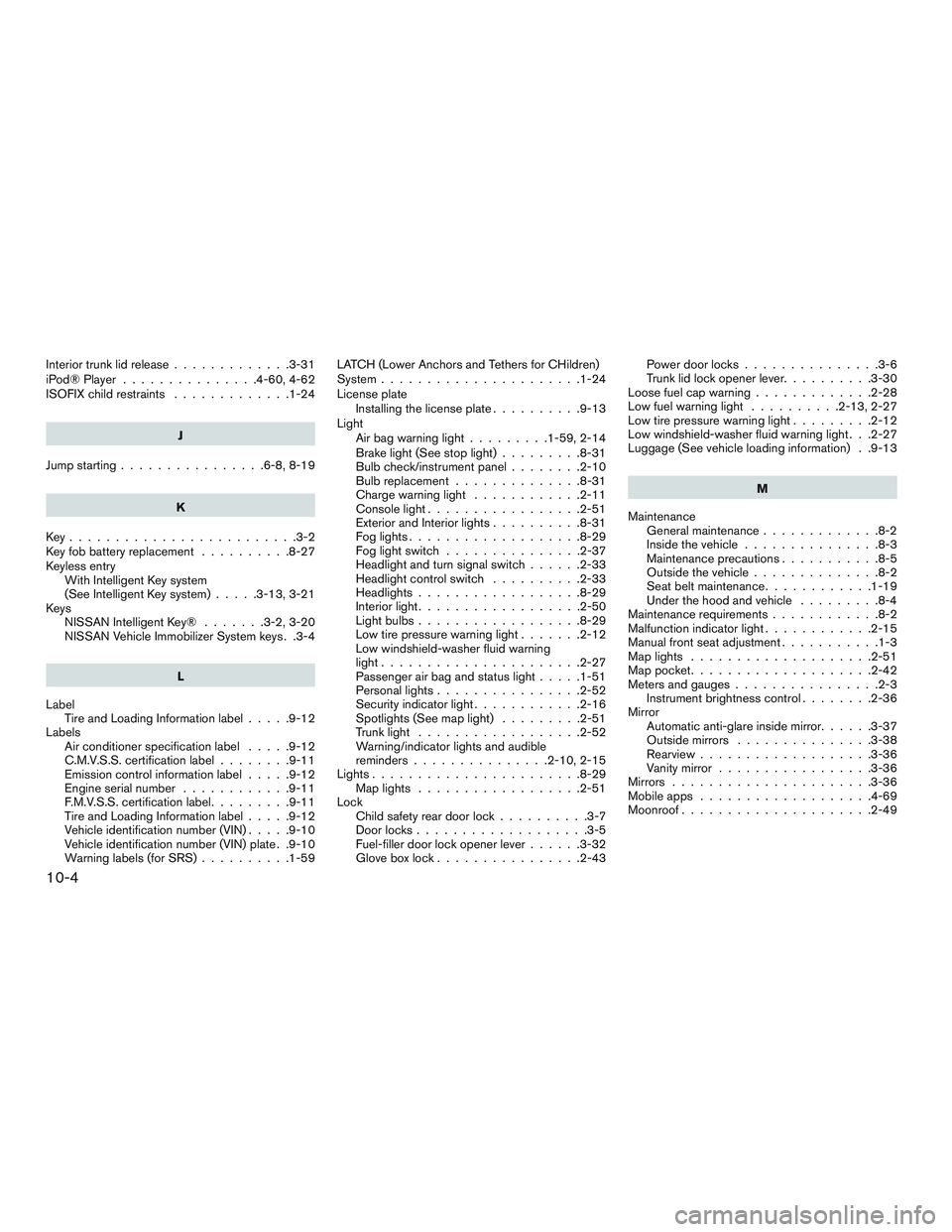
Interiortrunklidrelease.............3-31
iPod®Player ...............4-60,4-62
ISOFIX child restraints.............1-24
J
Jump starting ................6-8,8-19
K
Key.........................3-2
Key fob battery replacement ..........8-27
Keyless entry With Intelligent Key system
(See Intelligent Key system) .....3-13,3-21
Keys NISSAN Intelligent Key® .......3-2,3-20
NISSAN Vehicle Immobilizer System keys . .3-4
L
Label Tire and Loading Information label .....9-12
Labels Air conditioner specification label .....9-12
C.M.V.S.S. certification label ........9-11
Emissioncontrolinformationlabel.....9-12
Engine serial number ............9-11
F.M.V.S.S. certification label .........9-11
Tire and Loading Information label .....9-12
Vehicle identification number (VIN) .....9-10
Vehicle identification number (VIN) plate . .9-10
Warning labels (for SRS) ..........1-59LATCH (Lower Anchors and Tethers for CHildren)
System
......................1-24
License plate Installing the license plate ..........9-13
Light Air bag warning light .........1-59,2-14
Brake light (See stop light) .........8-31
Bulb check/instrument panel ........2-10
Bulbreplacement..............8-31
Charge warning light ............2-11
Consolelight.................2-51
Exterior and Interior lights ..........8-31
Foglights...................8-29
Foglightswitch ...............2-37
Headlight and turn signal switch ......2-33
Headlight control switch ..........2-33
Headlights..................8-29
Interiorlight..................2-50
Lightbulbs..................8-29
Low tire pressure warning light .......2-12
Low windshield-washer fluid warning
light......................2-27
Passenger air bag and status light .....1-51
Personal lights ................2-52
Security indicator light ............2-16
Spotlights(Seemaplight) .........2-51
Trunklight ..................2-52
Warning/indicator lights and audible
reminders ...............2-10,2-15
Lights.......................8-29 Maplights ..................2-51
Lock Child safety rear door lock ..........3-7
Door locks ...................3-5
Fuel-filler door lock opener lever ......3-32
Gloveboxlock................2-43 Power door locks
...............3-6
Trunk lid lock opener lever ..........3-30
Loose fuel cap warning .............2-28
Low fuel warning light ..........2-13,2-27
Low tire pressure warning light .........2-12
Low windshield-washer fluid warning light . . .2-27
Luggage (See vehicle loading information) . .9-13
M
Maintenance General maintenance .............8-2
Insidethevehicle...............8-3
Maintenance precautions ...........8-5
Outside the vehicle ..............8-2
Seat belt maintenance ............1-19
Under the hood and vehicle .........8-4
Maintenance requirements ............
8-2
Malfunction indicator light ............2-15
Manual front seat adjustment ...........1-3
Maplights ....................2-51
Mappocket....................2-42
Meters and gauges ................2-3
Instrument brightness control ........2-36
Mirror Automatic anti-glare inside mirror ......3-37
Outside mirrors ...............3-38
Rearview ...................3-36
Vanity mirror .................3-36
Mirrors ......................3-36
Mobileapps ...................4-69
Moonroof .....................2-49
10-4